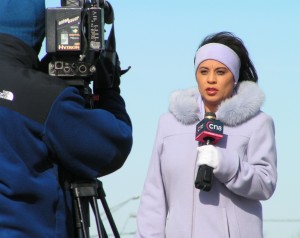the female news
‘When I started [in journalism], females were a little bit of a novelty,’ said The Morning Show co-host Kylie Gillies, in a 2013 interview with news.com.
Some might call this an understatement. In 1986, when Gillies was a 17-year-old cadet, women represented less than one quarter of Australian television news presenters. At the time, Australian reporters were a bastion of clean-shaven men in sharp suits. Women who did make it into the industry more often than not suffered sexism.
Caroline Wilson became Australia’s first full-time female AFL reporter in 1986, writing for The Herald. She describes breaking into the male-dominated industry as ‘terrifying… exciting.’
‘There was intimidation,’ she remembers. ‘Readers would write and complain.’ She was ‘kicked out’ of the sport team rooms and once forced by Allen Jeans to watch a replay of an injury to a man’s ‘confronting anatomy.’ In Wilson’s own words, ‘it was a different time.’
Last year, female journalists overtook their male colleagues, representing 55.5% of workers in the industry. This trend looks to continue into the future too, with women making up 70% of journalism students in Australia. Female journalists are making their presence clear – and it’s more than a bit inspiring.
Ten News presenter, Sandra Sully, notes that ‘there has been a seismic shift for women’ in media industries. On September 11, 2001, Sully was the first on Australian screens to report the terrorist bombings in America. She went on to become the face of Ten News, and to spearhead and manage Ten’s social media sites.
ABC foreign correspondent, Sophie McNeil made her first award-winning documentary at age 15. She’s now the recipient of a Walkley Award and has won Young Australian TV Journalist of the Year — twice. Travelling from Afghanistan to East Timor, McNeil has covered the rise of the Taliban and the Palestinian Civil War. Meanwhile, her fellow employee Sally Sara was the first female ABC correspondent to Africa, South Asia and Kabul, where she witnessed political conflict, uprisings and death. She has maintained an ethical outlook throughout. She recalls:
“Sometimes I was just frozen and I thought… I can’t film that. Sometimes it’s not the right thing to do… They brought the body out and I put the camera down; I wasn’t going to follow after someone carrying a body bag.”
More recently we’ve witnessed a number of female journalists press politicians on critical questions. ABC’s 7:30 host, Sarah Ferguson, pummelled Joe Hockey in his first television interview after delivering the 2014 national budget. Her first question asked, “Is it liberating for a politician to decide election promises don’t matter?” And who could forget Leigh Sales hammering Tony Abbott over untruths, into one of his infamous stunned silences (what I like to call, “Tone’s happy place”). In the past too, she has challenged Kevin Rudd and Wayne Swan.
These women are making significant contributions to Australian journalism, and mark progress in the industry’s gender equality. However, it would be folly to assume that Australia’s media industry is an equal playing field for men and women. Only one woman acts as chair of a major television network, and women comprise less than 22% of networks’ board members; there are no women on Channel Nine’s board or top management team.
Female journalists are younger and less experienced than male journalists, and receive ‘significantly lower salaries than men’ according to QUT’s Senior Lecturer in Journalism, Folker Hanusch; ‘only one-third… earn more than $72,000 a year, compared with around half of male journalists’. Overall, according to an investigation by New Matilda, ‘men still dominate the top levels of the media’, including top journalist and news maker positions.
The hardship experienced by female journalists is not universal, however. Sunrise co-host Natalie Barr feels that she has ‘never been discriminated against’. Meanwhile, though she notes that progress has been made, Indigenous news reporter Natalie Ahmat expressed the difficulties she has faced, saying, ‘it felt like I was a minority within a minority within a minority’.
Though there is a significant way to go, the inspiring work of Australian female journalists of late is changing the scene of Australian media, and is definitely worth our attention.



This is an interesting article! I think it’s fantastic to be aware of how far we’ve come in reaching equality.
The one thing that strikes me when I see female journalists on television is (more on commercial channels than ABC) that women must be thin and a standard of pretty to get in front of the camera. Men, however, are not held to the same rules.